| Author: | |
| Website: | |
| Page title: | |
| URL: | |
| Published: | |
| Last revised: | |
| Accessed: |
| Year: | 1981 |
| Original platform: | Arcade machine |
| Brief description: | Jump-and-run platform adventure game |
| Number of players: | One or two |
| Developers/contributors: | Nintendo |
Donkey Kong was the iconic game that signaled Nintendo's arrival on the world stage in terms of video gaming. Nintendo had already achieved a degree of success in Japan with their arcade games Sheriff, Space Firebird, and Radar Scope. The last mentioned of these was a Space Invaders clone, first released in Japan in 1980. The domestic success of Radar Scope fuelled Nintendo's ambitions to break into the US video game market, which at the time was booming.
To put things into perspective somewhat, it should be noted that these games were a departure from Nintendo's previous activities in the gaming market. They were programmable games that required relatively advanced electronic hardware. Nintendo had neither the in-house programming skills nor the manufacturing facilities to produce this kind of game on their own. They therefore turned to engineering firm Ikegami Co. Ltd. (also known as Ikegami Tsushinki).
Ikegami was one of several "shadow developers" - companies who provided software development services and electronic hardware to high-profile companies like Nintendo under contract. Their name does not appear in the credits of the original Donkey Kong arcade game, but can be found hidden in the game's read only memory (ROM). Nintendo, for their part, came up with the ideas for the games, designed and built the arcade cabinets, and handled the marketing side of things.
Nintendo president Hiroshi Yamauchi assigned the job of establishing a Nintendo presence in the United States to his son-in-law, Minoru Arakawa. Arakawa decided to use Nintendo's Radar Scope arcade game to spearhead the company's attempt to break into the US market, and placed an advance order for three thousand units with Ikegami. The completed arcade machines were duly shipped to Nintendo's Redmond, Washington distribution centre.
Although Nintendo managed to sell about a third of their Radar Scope arcade games, the game did not prove to be as popular in the United States as it had been in Japan. This left Nintendo with somewhere in the order of two thousand game units that they couldn't sell, which potentially represented a huge loss. Nintendo's dream of gaining a foothold in the US market almost ended there and then. Enter industrial artist Shigeru Miyamoto, who had joined Nintendo straight from college in 1977.
Miyamoto had entertained hopes of designing toys for Nintendo, but had instead been conscripted to design the cabinets and promotional art for Nintendo's coin operated games, including Radar Scope. Miyamoto must have demonstrated considerable talent, because when Arakawa asked his father-in-law for help in finding a way to somehow shift the unwanted cabinets, Yamauchi asked Miyamoto to design a new game to replace Radar Scope.
Nintendo had been negotiating for the rights to create a game based on the comic strip character Popeye. Although they were ultimately unsuccessful in this venture, Miyamoto became fixated on the relationship between the three main characters Popeye, (a sailor, and the character for whom the cartoon is named), Olive Oyl (his often fickle girlfriend) and Bluto (the dastardly and brutish villain who constantly tries to steal Olive away from Popeye).
He also apparently took inspiration from Merian C. Cooper's ground-breaking 1933 film King Kong, as well as from the classic fairy tale Beauty and the Beast. Miyamoto dreamed up a scenario in which the hero is a carpenter who has a pet gorilla and a girlfriend. All right, I know what you're thinking - there has to be a conflict of interests in there somewhere. Sure enough, the gorilla takes a shine to our hero's girlfriend and that's when the trouble starts.
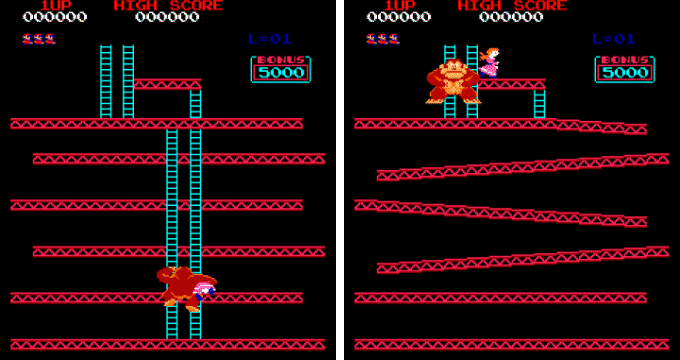
Screenshots from the opening scenes of an online playable version of Donkey Kong
(http://www.fetchfido.co.uk/games/donkey_kong/donkey_kong.htm)
As illustrated by the screenshots above, the game makes use of a cutscene to tell the player what has occurred prior to the start of the game itself. A cutscene is a video sequence over which the player has no control, but which can be used to (literally) set the scene and fill in any missing gaps in the storyline. In this case, the villainous ape of the title (Donkey Kong) has escaped and kidnapped our hero's girlfriend. He carries her to the top the first level of a building under construction (presumably, this is where our carpenter hero works).
Perhaps to emphasise that we are dealing with a large and powerful creature, Kong is shown stamping his feet in a show of rage, displacing several steel girders. Ladders ascending from the top of the highest girder should perhaps alert the observant player to the possibility that there may be further levels of the building above this one. Our hero must ascend the building and rescue his girlfriend using the ladders provided, jumping over gaps, and avoiding the various projectiles hurled at him by the belligerent ape.
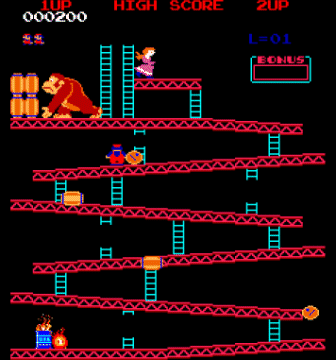
Kong hurls barrels and other projectiles at our hero
Donkey Kong gave rise to a whole new genre of game - the platform game. As the name implies, the player must navigate their character from one platform to the next by running, jumping or climbing. This type of game often involves the use of careful timing in order to ensure that the player's character does not plunge to an untimely death or run head-on into an obstacle. The player skills required are at a significantly higher level than those needed for games such as Space Invaders.
In the first level of Donkey Kong, our carpenter character must run along the steel girders, climb a ladder to get from one girder to the next, and jump over or otherwise avoid the objects thrown by Kong. These objects are at first mostly barrels, including the occasional oil barrel which catches fire and seems to have a life of its own, but will later include other equally lethal objects. It's not as easy to play as you might at first think.
The game introduced other elements not seen, or at least not fully explored, in previous games. There is for example a distinct, albeit somewhat outlandish, storyline. The game's main characters are depicted using cartoon-style graphics, and each is represented by a unique and highly recognisable sprite. Indeed, the two main protagonists would go on to feature in many later Nintendo games, and are still recognisable today, even in their original form.
Another innovation was the use of multiple stages within each level, the ordering of which could change as the player progressed through the levels. One of the abiding myths surrounding the game is that relating to the origin of the game's name, "Donkey Kong".
Some sources claim that the name was originally meant to be "Monkey Kong", but that the name had inadvertently been altered to "Donkey Kong", perhaps due to a blurred fax copy or typographical error. It later emerged, however, that Nintendo's Japanese management team wanted to give the game a name that meant "stubborn gorilla" or "stupid ape", but were unsure how to translate this correctly into English for the American market.
The word "donkey" was allegedly arrived at by consulting a Japanese-English dictionary for an English word that meant "stubborn" or "stupid". The word "kong" is apparently a common Japanese slang term for gorilla. Nintendo also assumed (probably correctly) that most people in the USA had seen, or were at least familiar with, the film King Kong, in which the central character is a giant gorilla.
Nintendo's US marketing team were skeptical at first about Donkey Kong's potential to appeal to the US game-playing public. It was very different, after all, from the popular shoot 'em up games of the period, such as Space Invaders and Asteroids. They were even more doubtful about the name "Donkey Kong", but at Yamauchi's insistence the name stayed. The Japanese management and development team members were far more optimistic than their US counterparts that the game would appeal to a western audience.
Nevertheless, in order to determine what kind of reception the game was likely to receive, Nintendo's marketing team in the US persuaded the proprietors of two bars in Seattle, Washington to set up Donkey Kong arcade machines on their premises. As we now know, the game proved to be every bit as popular as Nintendo had hoped.
Unfortunately, the game also attracted attention of a less desirable nature. Universal Studios, who produced the 1976 King Kong movie, soon became aware of the game and the enormous amount of revenue it was generating (Nintendo were selling over four thousand arcade units per month). Perhaps seeing an opportunity to cash in on this gaming phenomenon, they sued Nintendo for infringement of their rights to the name Kong and the plot of the movie, certain aspects of which had indeed provided inspiration for Miyamoto's game.
Universal lost both the lawsuit and a subsequent appeal. Nintendo were able to prove that universal had themselves used the argument, in respect of the 1933 movie produced by RKO Radio Pictures, that the name Kong and important elements of the plot were in the public domain. The episode demonstrated to Nintendo that they could hold their own, even against one of the giants of the US entertainment industry. It encouraged them to consolidate their new role as a major player in the US video game market.
The anglicised name of the player-controlled character was originally "Jumpman". This at least seems logical, since the character is required to spend a considerable amount of time jumping over gaps or obstacles. It also sounds a little like "Pac-Man", although whether this was intentional or purely a coincidence is a matter for conjecture. In later incarnations, the character's occupation would be changed from carpenter to plumber.
Before Donkey Kong's introduction to the United States, the name "Jumpman" was replaced with "Mario", apparently named after Mario Segale from whom Nintendo rented their office premises. Donkey Kong would be the first of many games featuring either Kong, Mario, or both of these enduring characters. The female character (Jumpman's hapless girlfriend) was initially called "the Lady", but was renamed "Pauline" for the US market after Polly James, the wife of Nintendo's Redmond warehouse manager Don James.

The original Mario sprite, greatly enlarged
Both the gameplay and the graphic representation of the characters were to a great extent dictated by the limitations of the hardware. In the development stage, Miyamoto worked closely with Nintendo's head engineer Gunpei Yokoi, who was tasked with overseeing the project by Yamauchi. Miyamoto wanted to depict the Mario character as an ordinary working man, someone with whom the average player could identify, which is perhaps why he is depicted as a carpenter (and later as a plumber).
The moustache and cap that were to become such recognisable features of the Mario character came about because they were easier to draw, given the limited number of pixels available, than a mouth and hair. Even the design of Mario's overalls, with the sleeves having a different colour from the body, was designed to make the movement of the character's arms easier to see.
Gameplay was also constrained by hardware considerations. Miyamoto, who was an artist and not a programmer, would run a number of ideas past Yokoi and the other members of the development team to see if they were technically feasible. What Miyamoto wanted to see on screen often proved to be not technically feasible, but the compromise eventually arrived at was usually better than satisfactory. Each level of the game is broken down into four distinct stages, with each stage featuring a twenty-five metre high section of the building under construction.
Mario must reach his girlfriend Pauline to complete each stage, after which she will again be grabbed by Kong. Kong then escapes to the next highest section of the building, with Pauline tucked under one arm. The game is accompanied by a simple but effective musical soundtrack which, although accredited by some sources to Miyamoto himself, is more often (and more plausibly) accredited to sound designer Yukio Kaneoka, who went on to create the music for many of Nintendo's other games.
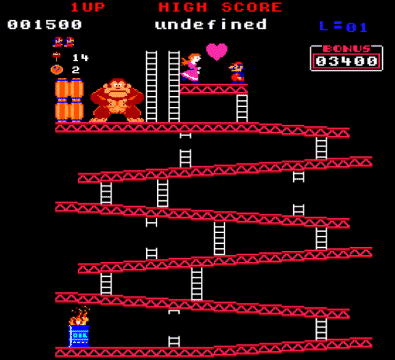
Mario manages to reach Pauline at the top of the first stage
(Another online version of Donkey Kong, available at: http://www.freekong.org/)
The first stage of the game is sometimes known as the ramp stage or girder stage. In this stage, Mario must run along the girders and ascend the ladders in order to reach Pauline, jumping over barrels and other projectiles dropped from above by Kong, or destroying them with a hammer (hammers are located at various points throughout the game, and Mario can grab a hammer by positioning himself underneath it and jumping up).
Alternatively, he can try to avoid these obstacles altogether. Using the hammer (which disappears again after a short time interval) has the disadvantage that Mario cannot climb a ladder or jump whilst wielding a hammer. If any of the projectiles (or Kong himself) touches Mario, he loses one of his three lives. If all lives are lost, the game is over. Once Mario reaches Pauline, a heart appears between them . . . only to break and disappear again as Kong recaptures Pauline and carries her off to the next stage.
In the second stage, sometimes called the conveyor belt stage, Mario has to climb ladders to get from one conveyor belt to the next. If running in the opposite direction to a conveyor belt, his progress will obviously be considerably slower than if he is running in the same direction as the belt.
The conveyor belts can also change direction without warning, and Kong again provides plenty of obstacles in the form of buckets of cement and fireballs. From the second stage onwards, Mario can gain extra points by collecting various personal effects dropped by the lovely Pauline as she is being carried off by Kong, such as a hat, a parasol, or a purse.
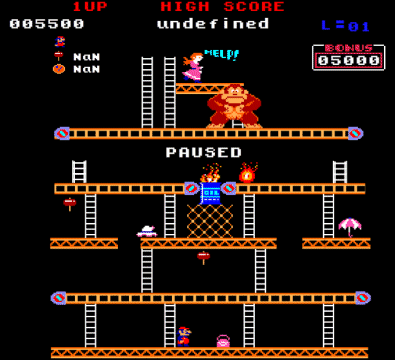
In stage two, Mario must negotiate ladders and conveyor belts
The third stage is often referred to as the elevator stage, for reasons that should be obvious. Mario must still use the ladders to climb, but at some stage he needs to also use the elevators to get from one side of the screen to the other and gain access to the ladder that will take him to Pauline. Any slip-ups and he will plunge to an untimely death. Kong meanwhile provides plenty of obstacles in the form of fireballs, bouncing springs and weights. Mario must also be careful not to become tangled up in the gears.
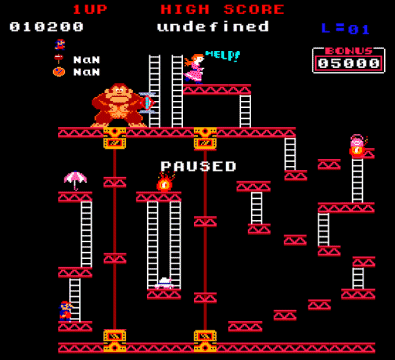
In stage three, Mario must climb ladders and jump to and from elevators
The last stage is often called the rivet stage or the long fall, because Mario can remove the rivets that hold the structure together in order to dislodge Kong, who will then fall to his death, allowing Mario to rescue his beloved Pauline. If this happens, Mario and Pauline are reunited and there is a short cutscene, after which the whole process starts again at the next level of difficulty.
The four stages are repeated in each new level, but become progressively more difficult. The order in which the stages appear may also vary, and some stages may even be omitted on some levels, depending on which version of the game you are playing. In the original arcade version, screen twenty-two became known as the kill screen, because a programming error causes Mario to be killed almost as soon as the level begins, and further progress is impossible.
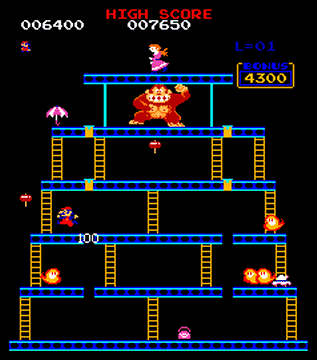
In stage four, Mario must dislodge Kong by removing eight rivets
(image credit: http://www.arcade-history.com)
Points are awarded for jumping over objects (or smashing them with the hammer), collecting Pauline's personal belongings, and of course for rescuing Pauline. At the beginning of each stage, a timer starts counting down. On completion of the stage, bonus points are awarded according to how much time is left on the clock. If the timer runs out, Mario loses a life and has to start the stage again from the beginning. By default, the player receives a bonus life if they manage to achieve seven thousand points.
The game's hardware is similar to that of other arcade games of the period. Most of the arcade machines were upright cabinets, with a number of cocktail table versions also being produced. Like Pac-Man, the game employed a Zilog Z80 microprocessor, but had somewhat more advanced sound circuitry. The visual display unit was a vertically oriented raster graphics monitor which could display two hundred and fifty-six colours.
A joystick was used to control Mario's movements (push the joystick left or right to run, and up or down to climb or descend ladders). Two buttons are also provided. One is used to make Mario jump, and the other is used before the game commences to select either a one- or two-player game. Pushing the joystick left or right while pressing the jump button makes Mario perform a running jump. For the home console and home computer versions of the game, a keypad or keyboard is used to control Mario.
Donkey Kong has probably spawned more sequels, clones and spinoffs than any other video game to date, including the hugely successful Super Mario Brothers. The first arcade sequel to Donkey Kong was called Donkey Kong Junior, and was released in 1982. In this game, Mario and Donkey Kong swap roles. This time Mario is the villain of the piece having imprisoned the unfortunate Kong.
Donkey Kong Junior is Donkey Kong's son, and must rescue his father from Mario's clutches. The second arcade sequel, released in 1983, was called simply Donkey Kong 3. This sequel did not feature Mario and was more like a shooter than a platform game. It features a character called Stanley who, armed only with an insecticide spray gun, must protect the plants in his greenhouse from being devoured by a swarm of angry bees, apparently stirred up by the actions of Donkey Kong.
The huge success of the arcade game versions naturally led to numerous ports of these games to other platforms. A simplified version of Donkey Kong was ported to Nintendo's own hand-held Game & Watch console, and versions of Donkey Kong and its spin-offs have appeared on just about every hand-held or home console produced by Nintendo up to the present day, including the Nintendo Entertainment System (NES), Super Nintendo Entertainment System (SNES), Gameboy, Gameboy Advance, Nintendo DS, and of course the Wii. No doubt there are more Donkey Kong spin-offs to come.
In the wake of Donkey Kong's initial success, US toy company Coleco were competing with Atari for the right to produce the home console version, a contest in which Coleco triumphed. As a consolation prize, Atari won the rights to port the game for home computers, and versions duly appeared for just about every popular home computer of the day, including Atari's own 8-bit computers, the Apple II, and the IBM PC.
Although the Donkey Kong franchise is still going strong today, there was a period of approximately ten years (from 1984 to 1994) when nothing very much happened, probably due in part to the video game market crash that occurred in 1983. There was a resurgence of activity in the mid-nineties, when the original game was resurrected for Nintendo's Gameboy hand-held console.
The same year saw the emergence of a new generation of games based around the character of Kong, together with a whole host of new characters. The first of these was Donkey Kong Country, developed by the British video game development company Rare Ltd. Rare followed up in 1995 with Donkey Kong Land. Both games were well received, and both have spawned a number of sequels and spin-offs.
Donkey Kong has been around in one form or another now for over thirty years. Although the glory days are perhaps over, there is no sign of him disappearing from the video game stage any time soon. Kong's legacy goes beyond the world of video gaming. Kong himself and many other memorable characters from the Nintendo gaming world, including Nintendo's best known character Mario, have starred in their own television shows and cartoons.
Kong and company have been featured on cereal packets, T-shirts, lunch boxes and literally hundreds of other products. Like Pac-Man before him, Donkey Kong was the subject of a song from pop duo Buckner and Garcia called "Do the Donkey Kong", released in 1982. In fact, Kong-related characters, music, sound effects or references have popped up in just about every form of popular media during the last thirty years or so.